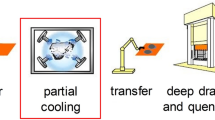Conclusions
Copper transmission lines with a cross section of 100 mm2 (56% reduction), and particularly 85 mm2 (68% reduction), soften at working temperatures.
Under the simultaneous influence of temperature and tensile stresses inducing elastic deformation the rate of softening increases substantially. Bronze softened considerably less under the same conditions, allowing the permissible current load and tensile load to be increased without danger of softening.
Similar content being viewed by others
Literature cited
V. Ya. Berent and A. A. Portselan, Strength and Structural Changes in Transmission Lines, TsNII MPS Report No. 337 [in Russian], Transport, Moscow (1968).
G. Hausslez and W. Zange, Rekristallisation Metallisch Werkstoffe, Leipzig (1966).
Blaze, Australian Inst. Metals,4, No. 3 (1959).
Additional information
Translated from Metallovedenie i Termicheskaya Obrabotka Metallov, No. 2, pp. 29–31, February, 1969.
Rights and permissions
About this article
Cite this article
Berent, V.Y., Portselan, A.A. & Vikker, I.V. The softening temperature of copper and bronze transmission lines. Met Sci Heat Treat 11, 111–113 (1969). https://doi.org/10.1007/BF00652277
Issue Date:
DOI: https://doi.org/10.1007/BF00652277




